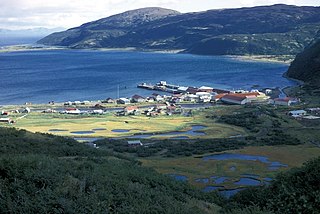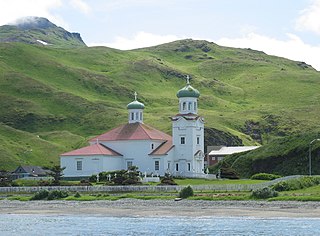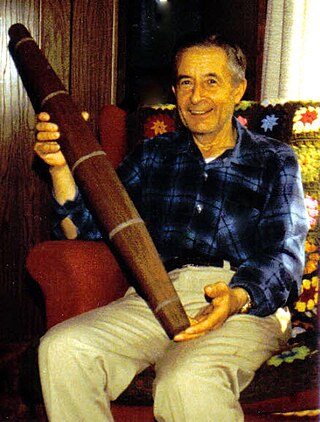
The Aleuts are the indigenous people of the Aleutian Islands, which are located between the North Pacific Ocean and the Bering Sea. Both the Aleut people and the islands are politically divided between the US state of Alaska and the Russian administrative division of Kamchatka Krai. This group is also known as the Unangax̂ (Oo-NUNG-ukh) in Unangam Tunuu, the Aleut language.

The state flag of Alaska displays eight gold stars, forming the Big Dipper and Polaris, on a dark blue field. The Big Dipper is an asterism in the constellation Ursa Major which symbolizes a bear, an animal indigenous to Alaska. As depicted on the flag, its stars can be used as a guide by the novice to locate Polaris and determine true north, which varies considerably from magnetic north.

Nikolski is a census-designated place (CDP) on Umnak Island in Aleutians West Census Area, Alaska, United States. The population was 39 at the 2020 census, up from 18 in 2010. Nikolski is on Nikolski Bay, off the southwest end of the island. It is 116 air miles west of Unalaska, and 900 air miles from Anchorage. Residents are known as Unangan, and Aleut is spoken in most of the remaining homes.

The City of Unalaska is the main population center in the Aleutian Islands. The city is in the Aleutians West Census Area, a regional component of the Unorganized Borough in the U.S. state of Alaska. Unalaska is located on Unalaska Island and neighboring Amaknak Island in the Aleutian Islands off mainland Alaska. The population was 4,254 at the 2020 census, which is 81% of the entire Aleutians West Census Area. Unalaska is the second largest city in the Unorganized Borough, behind Bethel.

Seward is an incorporated home rule city in Alaska, United States. Located on Resurrection Bay, a fjord of the Gulf of Alaska on the Kenai Peninsula, Seward is situated on Alaska's southern coast, approximately 120 miles (190 km) by road from Alaska's largest city, Anchorage.

Chignik is a city in Lake and Peninsula Borough, Alaska, United States. It is two hundred and fifty miles southwest of Kodiak. At the 2020 census the population was 97, up from 91 in 2010.

Cook Inlet stretches 180 miles (290 km) from the Gulf of Alaska to Anchorage in south-central Alaska. Cook Inlet branches into the Knik Arm and Turnagain Arm at its northern end, almost surrounding Anchorage. On its southern end, it merges with Shelikof Strait, Stevenson Entrance, Kennedy Entrance and Chugach Passage.

Dutch Harbor is a harbor on Amaknak Island in Unalaska, Alaska. It was the location of the Battle of Dutch Harbor in June 1942, and was one of the few sites in the United States to be subjected to aerial bombardment by a foreign power during World War II. It was also one of the few sites, besides the attack on Pearl Harbor in Hawaii, in incorporated U.S. territory to be bombed by the Japanese in the war.

The Alaska Peninsula is a peninsula extending about 800 km (497 mi) to the southwest from the mainland of Alaska and ending in the Aleutian Islands. The peninsula separates the Pacific Ocean from Bristol Bay, an arm of the Bering Sea.

Alaska's Flag is the state song of Alaska.
Alaska Pacific University (APU) is a private university in Anchorage, Alaska. It was established as Alaska Methodist University in 1957. Although it was renamed to Alaska Pacific University in 1978, it is still affiliated with the United Methodist Church. The main campus is located adjacent to the University of Alaska Anchorage (UAA) and the Alaska Native Medical Center.

The history of Alaska dates back to the Upper Paleolithic period, when foraging groups crossed the Bering land bridge into what is now western Alaska. At the time of European contact by the Russian explorers, the area was populated by Alaska Native groups. The name "Alaska" derives from the Aleut word Alaxsxaq, meaning "mainland".

John Ben Benson Jr. was an Alaska native best known for designing the flag of Alaska. Benson was age 14 years old when he won a contest in 1927 to design the flag for the Territory of Alaska, which became a U.S. state on January 3, 1959.
Anfesia Shapsnikoff was an Aleut leader and educator born October 1, 1901, at Atka, Alaska, in the Aleutian Islands. Renowned for her weaving of Aleut grass baskets, Anfesia flew to many communities throughout Alaska to teach children the lost art of Attu basket weaving.

The Church of the Holy Ascension, also known as the Holy Ascension Orthodox Church, is a prominent landmark in Unalaska, the major community of the western Aleutian Islands in southwestern Alaska. The current church was built in 1894, probably on the site of an 1826 church, and likely using timbers and other elements from the older church. It is one of the oldest churches in Alaska, and is significant as the site from which missionaries brought their religion to the local Aleut people. This evangelization effort was so successful that today's Aleut population is still strongly Orthodox. The church was declared a National Historic Landmark for its architecture, and for its role in the history and culture of Alaska. It is the second cathedral church of the Orthodox Church in America Diocese of Alaska, after St. Michael's Cathedral in Sitka.

Sergie Sovoroff was an Unangax̂ educational leader. He was born on Umnak Island in the Unangax̂ village of Nikolski in 1902. Sovoroff was born only nine years before the United States government outlawed sea otter hunting.

Andrew Gronholdt was a famous Aleut from Sand Point, Alaska, in the Shumagin Islands south of the lower Alaska Peninsula and became famous for rejuvenating the ancient Unangan art of carving hunting hats called chagudax. In January 2012, a book was published posthumously by Gronholdt titled "Chagudax: A Small Window into the Life of An Aleut Bentwood Hat Carver" Gronholdt's woodworking techniques, wood steaming and bending methods, and instructional design methodologies were legendary.

The Aleutian Islands, also called the Aleut Islands or Aleutic Islands and known before 1867 as the Catherine Archipelago, are a chain of 14 large volcanic islands and 55 smaller islands. Most of the Aleutian Islands belong to the U.S. state of Alaska, but some belong to the Russian federal subject of Kamchatka Krai. They form part of the Aleutian Arc in the Northern Pacific Ocean, occupying a land area of 6,821 sq mi (17,666 km2) and extending about 1,200 mi (1,900 km) westward from the Alaska Peninsula toward the Kamchatka Peninsula in Russia, and act as a border between the Bering Sea to the north and the Pacific Ocean to the south. Crossing longitude 180°, at which point east and west longitude end, the archipelago contains both the westernmost part of the United States by longitude and the easternmost by longitude. The westernmost U.S. island in real terms, however, is Attu Island, west of which runs the International Date Line. While nearly all the archipelago is part of Alaska and is usually considered as being in the "Alaskan Bush", at the extreme western end, the small, geologically related Commander Islands belong to Russia.

Kathryn Dyakanoff Seller (1884–1980) was an Alaskan Creole educator. With her husband, she built and opened the first government-funded schoolhouse in the Aleutian Islands, in 1909.
Daisy Lee Bitter is an American science educator. She was named to the Alaska Women's Hall of Fame in 2015.




















